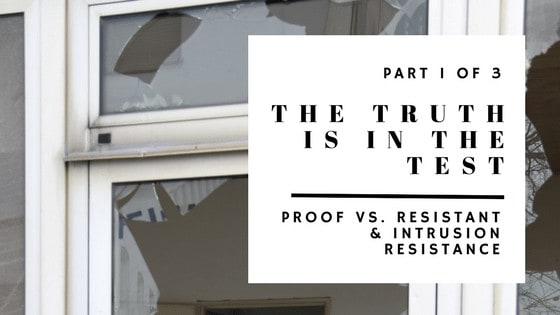
PART 1 of 3 – Proof vs. Resistant & Forced Entry (Intrusion) Resistance
There is a growing need to create entrances in our schools, businesses, and government facilities that are blast, bullet, intrusion, and storm resistant. It is sad to think that we live in a time where we need to design entrance solutions for keeping our families and property safe, but we must continually innovate to overcome the threats that present themselves in daily life.
Within this growing segment of the industry, we find a new set of labels, terminology, and testing standards. At times these can get quite confusing and misleading. However, they do not need to be if you have a good understanding of a few key terms.
Proof vs. Resistant
Have you ever heard someone say that an object was Something Proof and in reality, it should have been Something Resistant? According to Webster’s Dictionary, the definition of proof is: “Able to withstand something damaging; resistant.” Ok, that makes sense… until you look up the definition of resistant in the same dictionary. That definition goes something like this: “Opposed to something; wanting to prevent something from happening.” So, proof or resistant, tomato or tomato? They should mean the same thing, not exactly. The “proof” is in the pudding.
Yes, bulletproof sounds more impressive than bullet resistant. Using the term bulletproof is an absolute statement and not an entirely factual statement. At the end of the day, if someone or something wants in, the laws of physics will work against you. If something is big enough, powerful enough, hard enough, wet enough, fast enough– you get the picture– it’s coming in. For this reason, I would rather see the term “resistant” used in all descriptions having anything to do with bullet, blast, intrusion or storm rated entrance systems.
What is Intrusion Resistance?
If you are looking for solutions that would slow down a perpetrator from gaining access to your building, one of the options is to add intrusion resistant glazing to your entrance. The definition of intrusion is; “the act or an instance of intruding; an unwelcome visit.” Intrusion resistant products are also commonly called attack resistant or forced entry resistant.
Intrusion Resistance Testing
There are several test standards used depending on the approval. The most common are ASTM and UL (Underwriters Laboratories), and the U.S. State Department forced entry test. Also, some state correction facilities utilize their own set of standards. Some companies are trying to “update” the current standards that would better represent current conditions.
Depending on the data that you look at, the national average for the police to respond to a 911 call is between 6 and 10 minutes. The goal of an intrusion resistant entrance system is to delay intruders from gaining access until the cavalry arrives. These systems may or may not be bullet resistant but remember the object here is to delay the intruder from gaining access to the facility not to stop a bullet.
Intrusion Resistant Glass and Glazing
There are two innovative variations of intrusion resistant glazing that can be utilized for this requirement.
One option is a patent pending product that slows down intruders up to twelve minutes before gaining access. The laminated glass comes in 5/16″ and 1″ insulated. This glass is a bit more expensive but provides all the benefits of a glass vision lite that an end user may prefer.
The second option is a clear polycarbonate that has a scratch resistant coating. I strongly suggest packing a lunch if you are trying to break through this material. You can literally go after it with a sledgehammer and not break it! This polycarbonate is an inexpensive solution for intrusion resistance.
A Complete Forced-Entry Resistant System
It is important to note that the glazing material is only one aspect of an intrusion resistant system. The doors and vision lite kits used to hold this glazing material are just as important. They must all work as a system to counteract the threat. When selecting intrusion resistant products, it is important that you choose intrusion-resistant doors, frames, glazing, and vision lite kits. Manufacturers typically reinforce vision lite kits with more fasteners and material to allow the system to withstand a threat. I know what you’re thinking: More fasteners? No one is going to buy that! Well, just because there are more fasteners doesn’t mean you have to see them! Some companies have developed ingenious ways of disguising their intrusion resistant glazing kits so to the average person it does not look reinforced.
Stay Tuned
Read the rest of this blog series to find out why it’s important to direct attention to testing standards when explaining the levels of protection or comparing products!
More from this Series:
Part 2 of 3: Hurricane and Storm Resistance
Part 3 of 3: Bullet Resistance, Blast Resistance, and How to Choose a Level of Protection